401077 Biostatistics Assignment 3: STROBE and Regression Analysis
VerifiedAdded on 2022/09/29
|6
|1823
|29
Homework Assignment
AI Summary
This biostatistics assignment analyzes a dataset related to grandparent carers, focusing on handgrip strength, BMI, and occupational history. The assignment begins with an appraisal of the statistical material in Moy et al. (2015) against the STROBE checklist, evaluating the strengths and weaknesses of the study's presentation of statistical methods. The student then presents descriptive statistics, including tables and graphs, to summarize the data. Subsequently, the assignment delves into inferential analyses, including regression models to examine the relationship between handgrip strength and BMI, and t-tests to compare handgrip strength across different occupational groups. The student sets up hypotheses, selects test statistics, establishes decision rules, computes test statistics, and draws conclusions from the analyses. Finally, the assignment concludes with an interpretation of the research question, summarizing the key findings regarding the influence of BMI and occupation on handgrip strength.
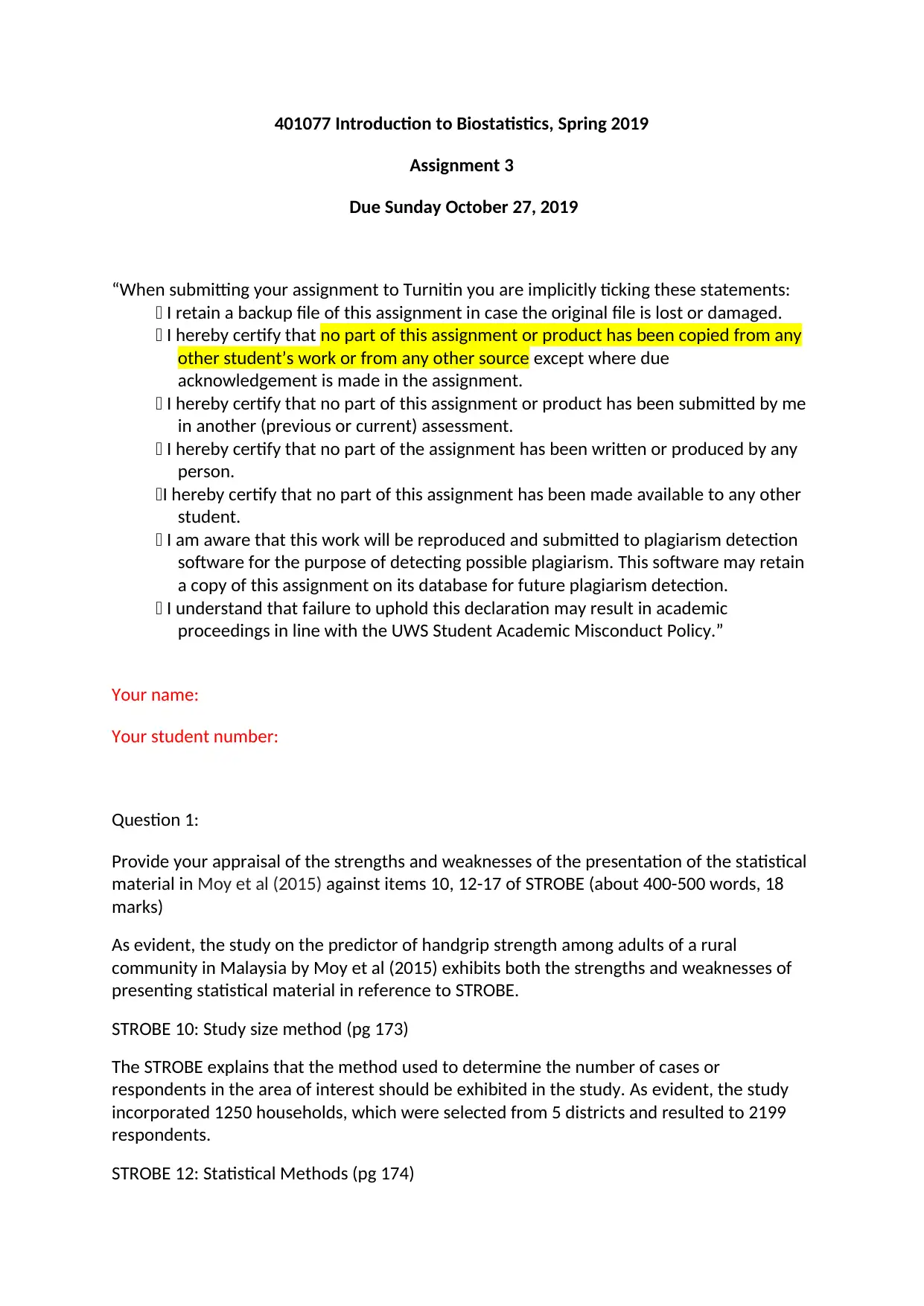
401077 Introduction to Biostatistics, Spring 2019
Assignment 3
Due Sunday October 27, 2019
“When submitting your assignment to Turnitin you are implicitly ticking these statements:
I retain a backup file of this assignment in case the original file is lost or damaged.
I hereby certify that no part of this assignment or product has been copied from any
other student’s work or from any other source except where due
acknowledgement is made in the assignment.
I hereby certify that no part of this assignment or product has been submitted by me
in another (previous or current) assessment.
I hereby certify that no part of the assignment has been written or produced by any
person.
I hereby certify that no part of this assignment has been made available to any other
student.
I am aware that this work will be reproduced and submitted to plagiarism detection
software for the purpose of detecting possible plagiarism. This software may retain
a copy of this assignment on its database for future plagiarism detection.
I understand that failure to uphold this declaration may result in academic
proceedings in line with the UWS Student Academic Misconduct Policy.”
Your name:
Your student number:
Question 1:
Provide your appraisal of the strengths and weaknesses of the presentation of the statistical
material in Moy et al (2015) against items 10, 12-17 of STROBE (about 400-500 words, 18
marks)
As evident, the study on the predictor of handgrip strength among adults of a rural
community in Malaysia by Moy et al (2015) exhibits both the strengths and weaknesses of
presenting statistical material in reference to STROBE.
STROBE 10: Study size method (pg 173)
The STROBE explains that the method used to determine the number of cases or
respondents in the area of interest should be exhibited in the study. As evident, the study
incorporated 1250 households, which were selected from 5 districts and resulted to 2199
respondents.
STROBE 12: Statistical Methods (pg 174)
Assignment 3
Due Sunday October 27, 2019
“When submitting your assignment to Turnitin you are implicitly ticking these statements:
I retain a backup file of this assignment in case the original file is lost or damaged.
I hereby certify that no part of this assignment or product has been copied from any
other student’s work or from any other source except where due
acknowledgement is made in the assignment.
I hereby certify that no part of this assignment or product has been submitted by me
in another (previous or current) assessment.
I hereby certify that no part of the assignment has been written or produced by any
person.
I hereby certify that no part of this assignment has been made available to any other
student.
I am aware that this work will be reproduced and submitted to plagiarism detection
software for the purpose of detecting possible plagiarism. This software may retain
a copy of this assignment on its database for future plagiarism detection.
I understand that failure to uphold this declaration may result in academic
proceedings in line with the UWS Student Academic Misconduct Policy.”
Your name:
Your student number:
Question 1:
Provide your appraisal of the strengths and weaknesses of the presentation of the statistical
material in Moy et al (2015) against items 10, 12-17 of STROBE (about 400-500 words, 18
marks)
As evident, the study on the predictor of handgrip strength among adults of a rural
community in Malaysia by Moy et al (2015) exhibits both the strengths and weaknesses of
presenting statistical material in reference to STROBE.
STROBE 10: Study size method (pg 173)
The STROBE explains that the method used to determine the number of cases or
respondents in the area of interest should be exhibited in the study. As evident, the study
incorporated 1250 households, which were selected from 5 districts and resulted to 2199
respondents.
STROBE 12: Statistical Methods (pg 174)
Paraphrase This Document
Need a fresh take? Get an instant paraphrase of this document with our AI Paraphraser
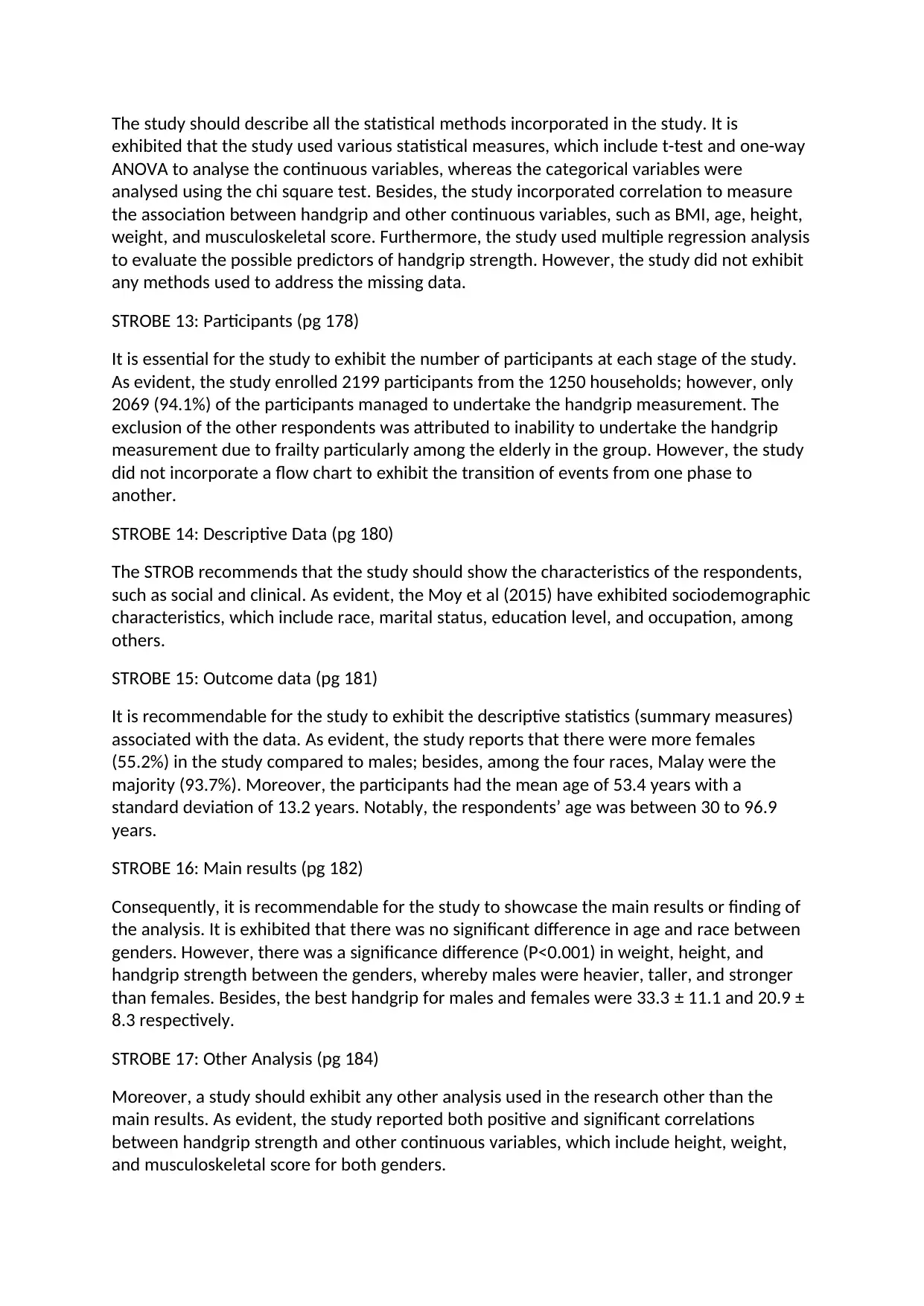
The study should describe all the statistical methods incorporated in the study. It is
exhibited that the study used various statistical measures, which include t-test and one-way
ANOVA to analyse the continuous variables, whereas the categorical variables were
analysed using the chi square test. Besides, the study incorporated correlation to measure
the association between handgrip and other continuous variables, such as BMI, age, height,
weight, and musculoskeletal score. Furthermore, the study used multiple regression analysis
to evaluate the possible predictors of handgrip strength. However, the study did not exhibit
any methods used to address the missing data.
STROBE 13: Participants (pg 178)
It is essential for the study to exhibit the number of participants at each stage of the study.
As evident, the study enrolled 2199 participants from the 1250 households; however, only
2069 (94.1%) of the participants managed to undertake the handgrip measurement. The
exclusion of the other respondents was attributed to inability to undertake the handgrip
measurement due to frailty particularly among the elderly in the group. However, the study
did not incorporate a flow chart to exhibit the transition of events from one phase to
another.
STROBE 14: Descriptive Data (pg 180)
The STROB recommends that the study should show the characteristics of the respondents,
such as social and clinical. As evident, the Moy et al (2015) have exhibited sociodemographic
characteristics, which include race, marital status, education level, and occupation, among
others.
STROBE 15: Outcome data (pg 181)
It is recommendable for the study to exhibit the descriptive statistics (summary measures)
associated with the data. As evident, the study reports that there were more females
(55.2%) in the study compared to males; besides, among the four races, Malay were the
majority (93.7%). Moreover, the participants had the mean age of 53.4 years with a
standard deviation of 13.2 years. Notably, the respondents’ age was between 30 to 96.9
years.
STROBE 16: Main results (pg 182)
Consequently, it is recommendable for the study to showcase the main results or finding of
the analysis. It is exhibited that there was no significant difference in age and race between
genders. However, there was a significance difference (P<0.001) in weight, height, and
handgrip strength between the genders, whereby males were heavier, taller, and stronger
than females. Besides, the best handgrip for males and females were 33.3 ± 11.1 and 20.9 ±
8.3 respectively.
STROBE 17: Other Analysis (pg 184)
Moreover, a study should exhibit any other analysis used in the research other than the
main results. As evident, the study reported both positive and significant correlations
between handgrip strength and other continuous variables, which include height, weight,
and musculoskeletal score for both genders.
exhibited that the study used various statistical measures, which include t-test and one-way
ANOVA to analyse the continuous variables, whereas the categorical variables were
analysed using the chi square test. Besides, the study incorporated correlation to measure
the association between handgrip and other continuous variables, such as BMI, age, height,
weight, and musculoskeletal score. Furthermore, the study used multiple regression analysis
to evaluate the possible predictors of handgrip strength. However, the study did not exhibit
any methods used to address the missing data.
STROBE 13: Participants (pg 178)
It is essential for the study to exhibit the number of participants at each stage of the study.
As evident, the study enrolled 2199 participants from the 1250 households; however, only
2069 (94.1%) of the participants managed to undertake the handgrip measurement. The
exclusion of the other respondents was attributed to inability to undertake the handgrip
measurement due to frailty particularly among the elderly in the group. However, the study
did not incorporate a flow chart to exhibit the transition of events from one phase to
another.
STROBE 14: Descriptive Data (pg 180)
The STROB recommends that the study should show the characteristics of the respondents,
such as social and clinical. As evident, the Moy et al (2015) have exhibited sociodemographic
characteristics, which include race, marital status, education level, and occupation, among
others.
STROBE 15: Outcome data (pg 181)
It is recommendable for the study to exhibit the descriptive statistics (summary measures)
associated with the data. As evident, the study reports that there were more females
(55.2%) in the study compared to males; besides, among the four races, Malay were the
majority (93.7%). Moreover, the participants had the mean age of 53.4 years with a
standard deviation of 13.2 years. Notably, the respondents’ age was between 30 to 96.9
years.
STROBE 16: Main results (pg 182)
Consequently, it is recommendable for the study to showcase the main results or finding of
the analysis. It is exhibited that there was no significant difference in age and race between
genders. However, there was a significance difference (P<0.001) in weight, height, and
handgrip strength between the genders, whereby males were heavier, taller, and stronger
than females. Besides, the best handgrip for males and females were 33.3 ± 11.1 and 20.9 ±
8.3 respectively.
STROBE 17: Other Analysis (pg 184)
Moreover, a study should exhibit any other analysis used in the research other than the
main results. As evident, the study reported both positive and significant correlations
between handgrip strength and other continuous variables, which include height, weight,
and musculoskeletal score for both genders.
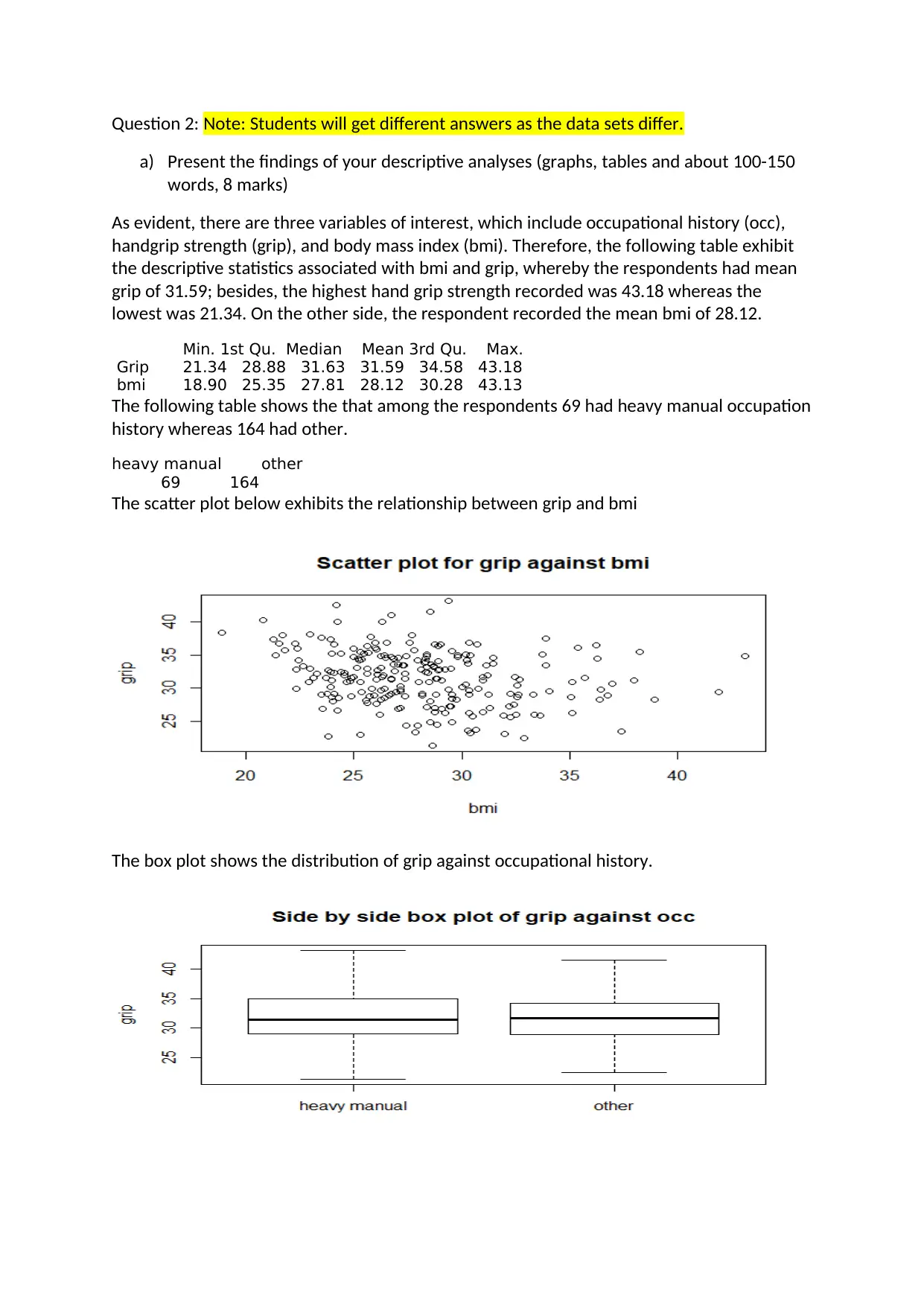
Question 2: Note: Students will get different answers as the data sets differ.
a) Present the findings of your descriptive analyses (graphs, tables and about 100-150
words, 8 marks)
As evident, there are three variables of interest, which include occupational history (occ),
handgrip strength (grip), and body mass index (bmi). Therefore, the following table exhibit
the descriptive statistics associated with bmi and grip, whereby the respondents had mean
grip of 31.59; besides, the highest hand grip strength recorded was 43.18 whereas the
lowest was 21.34. On the other side, the respondent recorded the mean bmi of 28.12.
Min. 1st Qu. Median Mean 3rd Qu. Max.
Grip 21.34 28.88 31.63 31.59 34.58 43.18
bmi 18.90 25.35 27.81 28.12 30.28 43.13
The following table shows the that among the respondents 69 had heavy manual occupation
history whereas 164 had other.
heavy manual other
69 164
The scatter plot below exhibits the relationship between grip and bmi
The box plot shows the distribution of grip against occupational history.
a) Present the findings of your descriptive analyses (graphs, tables and about 100-150
words, 8 marks)
As evident, there are three variables of interest, which include occupational history (occ),
handgrip strength (grip), and body mass index (bmi). Therefore, the following table exhibit
the descriptive statistics associated with bmi and grip, whereby the respondents had mean
grip of 31.59; besides, the highest hand grip strength recorded was 43.18 whereas the
lowest was 21.34. On the other side, the respondent recorded the mean bmi of 28.12.
Min. 1st Qu. Median Mean 3rd Qu. Max.
Grip 21.34 28.88 31.63 31.59 34.58 43.18
bmi 18.90 25.35 27.81 28.12 30.28 43.13
The following table shows the that among the respondents 69 had heavy manual occupation
history whereas 164 had other.
heavy manual other
69 164
The scatter plot below exhibits the relationship between grip and bmi
The box plot shows the distribution of grip against occupational history.
⊘ This is a preview!⊘
Do you want full access?
Subscribe today to unlock all pages.

Trusted by 1+ million students worldwide
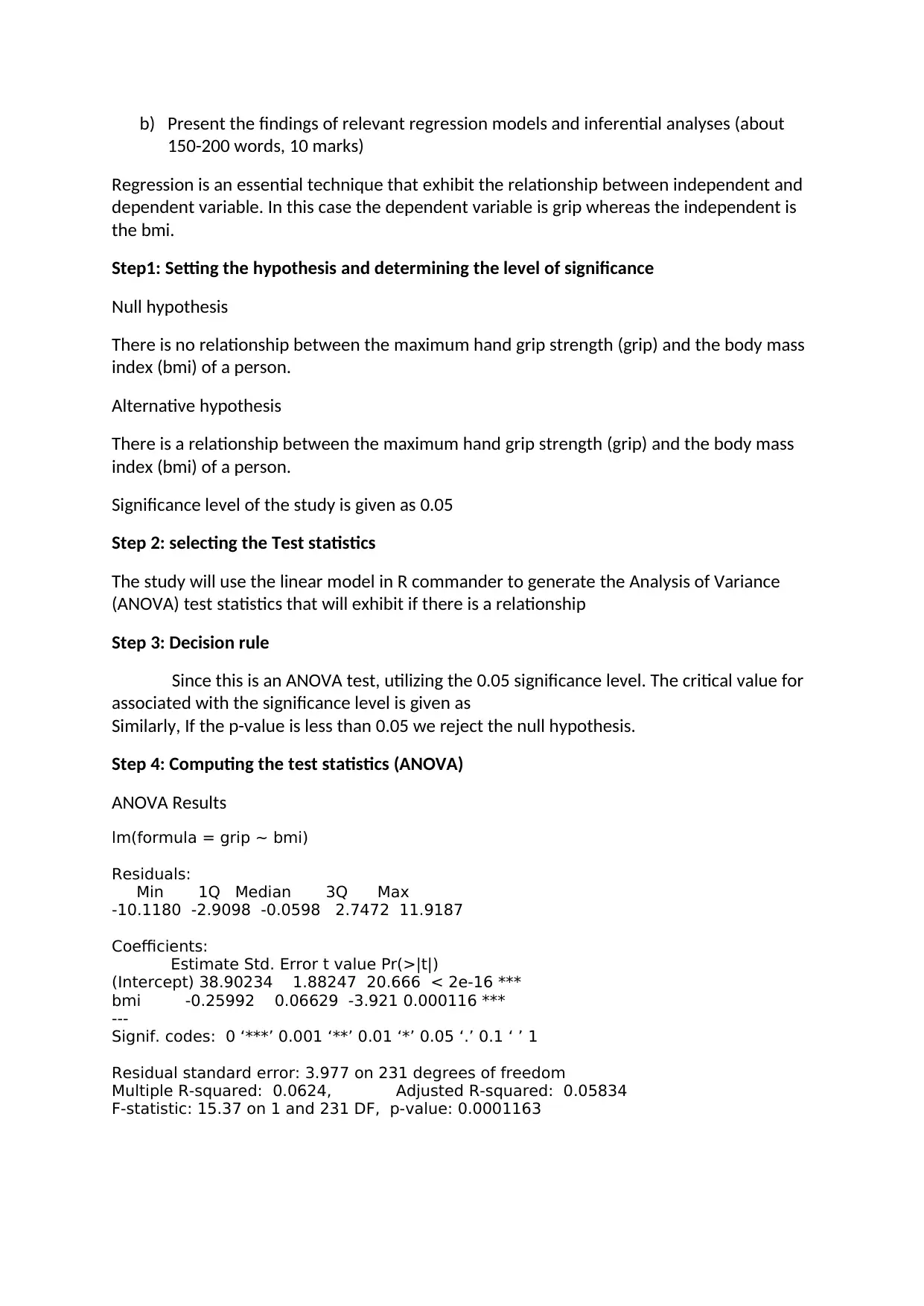
b) Present the findings of relevant regression models and inferential analyses (about
150-200 words, 10 marks)
Regression is an essential technique that exhibit the relationship between independent and
dependent variable. In this case the dependent variable is grip whereas the independent is
the bmi.
Step1: Setting the hypothesis and determining the level of significance
Null hypothesis
There is no relationship between the maximum hand grip strength (grip) and the body mass
index (bmi) of a person.
Alternative hypothesis
There is a relationship between the maximum hand grip strength (grip) and the body mass
index (bmi) of a person.
Significance level of the study is given as 0.05
Step 2: selecting the Test statistics
The study will use the linear model in R commander to generate the Analysis of Variance
(ANOVA) test statistics that will exhibit if there is a relationship
Step 3: Decision rule
Since this is an ANOVA test, utilizing the 0.05 significance level. The critical value for
associated with the significance level is given as
Similarly, If the p-value is less than 0.05 we reject the null hypothesis.
Step 4: Computing the test statistics (ANOVA)
ANOVA Results
lm(formula = grip ~ bmi)
Residuals:
Min 1Q Median 3Q Max
-10.1180 -2.9098 -0.0598 2.7472 11.9187
Coefficients:
Estimate Std. Error t value Pr(>|t|)
(Intercept) 38.90234 1.88247 20.666 < 2e-16 ***
bmi -0.25992 0.06629 -3.921 0.000116 ***
---
Signif. codes: 0 ‘***’ 0.001 ‘**’ 0.01 ‘*’ 0.05 ‘.’ 0.1 ‘ ’ 1
Residual standard error: 3.977 on 231 degrees of freedom
Multiple R-squared: 0.0624, Adjusted R-squared: 0.05834
F-statistic: 15.37 on 1 and 231 DF, p-value: 0.0001163
150-200 words, 10 marks)
Regression is an essential technique that exhibit the relationship between independent and
dependent variable. In this case the dependent variable is grip whereas the independent is
the bmi.
Step1: Setting the hypothesis and determining the level of significance
Null hypothesis
There is no relationship between the maximum hand grip strength (grip) and the body mass
index (bmi) of a person.
Alternative hypothesis
There is a relationship between the maximum hand grip strength (grip) and the body mass
index (bmi) of a person.
Significance level of the study is given as 0.05
Step 2: selecting the Test statistics
The study will use the linear model in R commander to generate the Analysis of Variance
(ANOVA) test statistics that will exhibit if there is a relationship
Step 3: Decision rule
Since this is an ANOVA test, utilizing the 0.05 significance level. The critical value for
associated with the significance level is given as
Similarly, If the p-value is less than 0.05 we reject the null hypothesis.
Step 4: Computing the test statistics (ANOVA)
ANOVA Results
lm(formula = grip ~ bmi)
Residuals:
Min 1Q Median 3Q Max
-10.1180 -2.9098 -0.0598 2.7472 11.9187
Coefficients:
Estimate Std. Error t value Pr(>|t|)
(Intercept) 38.90234 1.88247 20.666 < 2e-16 ***
bmi -0.25992 0.06629 -3.921 0.000116 ***
---
Signif. codes: 0 ‘***’ 0.001 ‘**’ 0.01 ‘*’ 0.05 ‘.’ 0.1 ‘ ’ 1
Residual standard error: 3.977 on 231 degrees of freedom
Multiple R-squared: 0.0624, Adjusted R-squared: 0.05834
F-statistic: 15.37 on 1 and 231 DF, p-value: 0.0001163
Paraphrase This Document
Need a fresh take? Get an instant paraphrase of this document with our AI Paraphraser
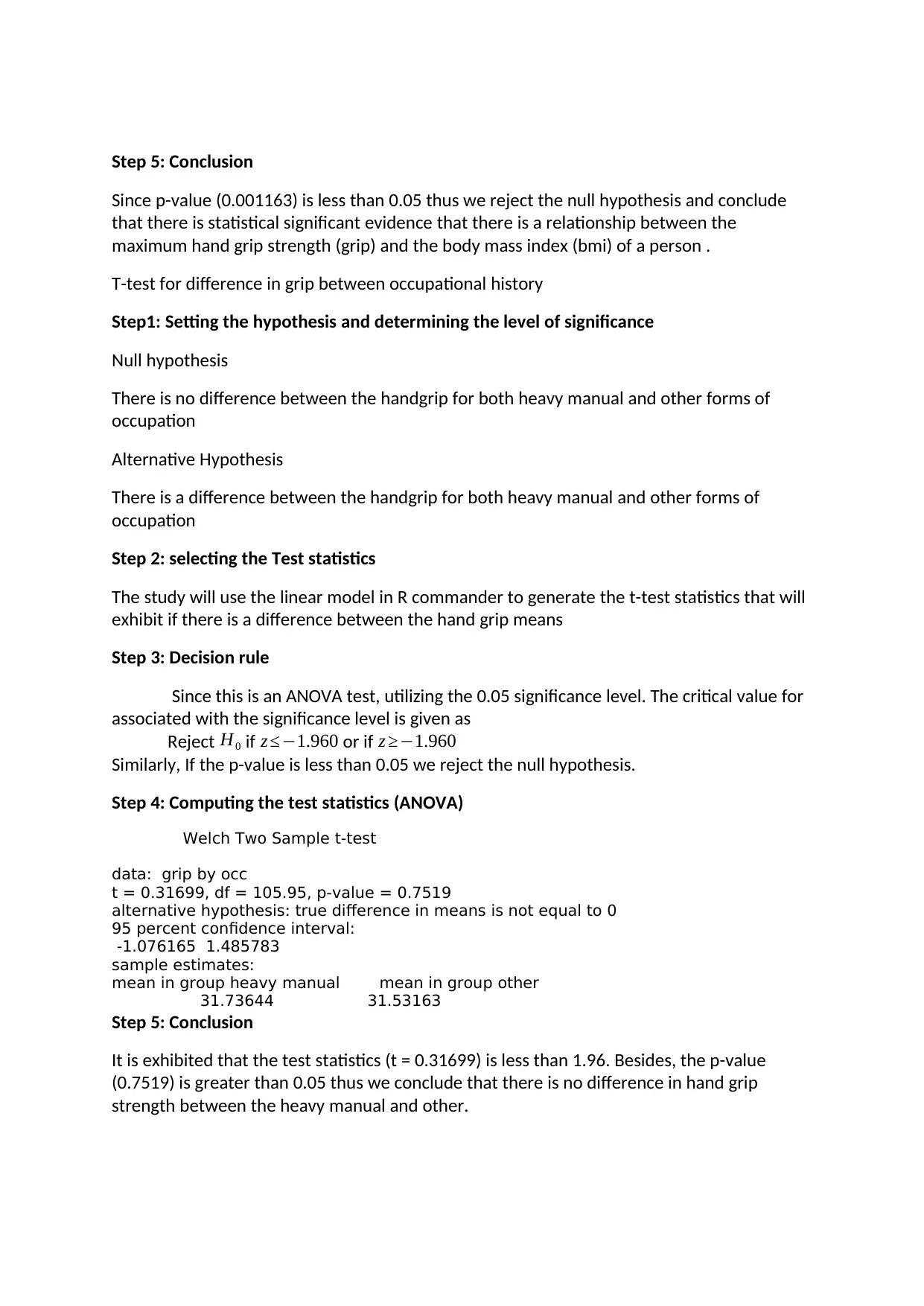
Step 5: Conclusion
Since p-value (0.001163) is less than 0.05 thus we reject the null hypothesis and conclude
that there is statistical significant evidence that there is a relationship between the
maximum hand grip strength (grip) and the body mass index (bmi) of a person .
T-test for difference in grip between occupational history
Step1: Setting the hypothesis and determining the level of significance
Null hypothesis
There is no difference between the handgrip for both heavy manual and other forms of
occupation
Alternative Hypothesis
There is a difference between the handgrip for both heavy manual and other forms of
occupation
Step 2: selecting the Test statistics
The study will use the linear model in R commander to generate the t-test statistics that will
exhibit if there is a difference between the hand grip means
Step 3: Decision rule
Since this is an ANOVA test, utilizing the 0.05 significance level. The critical value for
associated with the significance level is given as
Reject H0 if z ≤−1.960 or if z ≥−1.960
Similarly, If the p-value is less than 0.05 we reject the null hypothesis.
Step 4: Computing the test statistics (ANOVA)
Welch Two Sample t-test
data: grip by occ
t = 0.31699, df = 105.95, p-value = 0.7519
alternative hypothesis: true difference in means is not equal to 0
95 percent confidence interval:
-1.076165 1.485783
sample estimates:
mean in group heavy manual mean in group other
31.73644 31.53163
Step 5: Conclusion
It is exhibited that the test statistics (t = 0.31699) is less than 1.96. Besides, the p-value
(0.7519) is greater than 0.05 thus we conclude that there is no difference in hand grip
strength between the heavy manual and other.
Since p-value (0.001163) is less than 0.05 thus we reject the null hypothesis and conclude
that there is statistical significant evidence that there is a relationship between the
maximum hand grip strength (grip) and the body mass index (bmi) of a person .
T-test for difference in grip between occupational history
Step1: Setting the hypothesis and determining the level of significance
Null hypothesis
There is no difference between the handgrip for both heavy manual and other forms of
occupation
Alternative Hypothesis
There is a difference between the handgrip for both heavy manual and other forms of
occupation
Step 2: selecting the Test statistics
The study will use the linear model in R commander to generate the t-test statistics that will
exhibit if there is a difference between the hand grip means
Step 3: Decision rule
Since this is an ANOVA test, utilizing the 0.05 significance level. The critical value for
associated with the significance level is given as
Reject H0 if z ≤−1.960 or if z ≥−1.960
Similarly, If the p-value is less than 0.05 we reject the null hypothesis.
Step 4: Computing the test statistics (ANOVA)
Welch Two Sample t-test
data: grip by occ
t = 0.31699, df = 105.95, p-value = 0.7519
alternative hypothesis: true difference in means is not equal to 0
95 percent confidence interval:
-1.076165 1.485783
sample estimates:
mean in group heavy manual mean in group other
31.73644 31.53163
Step 5: Conclusion
It is exhibited that the test statistics (t = 0.31699) is less than 1.96. Besides, the p-value
(0.7519) is greater than 0.05 thus we conclude that there is no difference in hand grip
strength between the heavy manual and other.
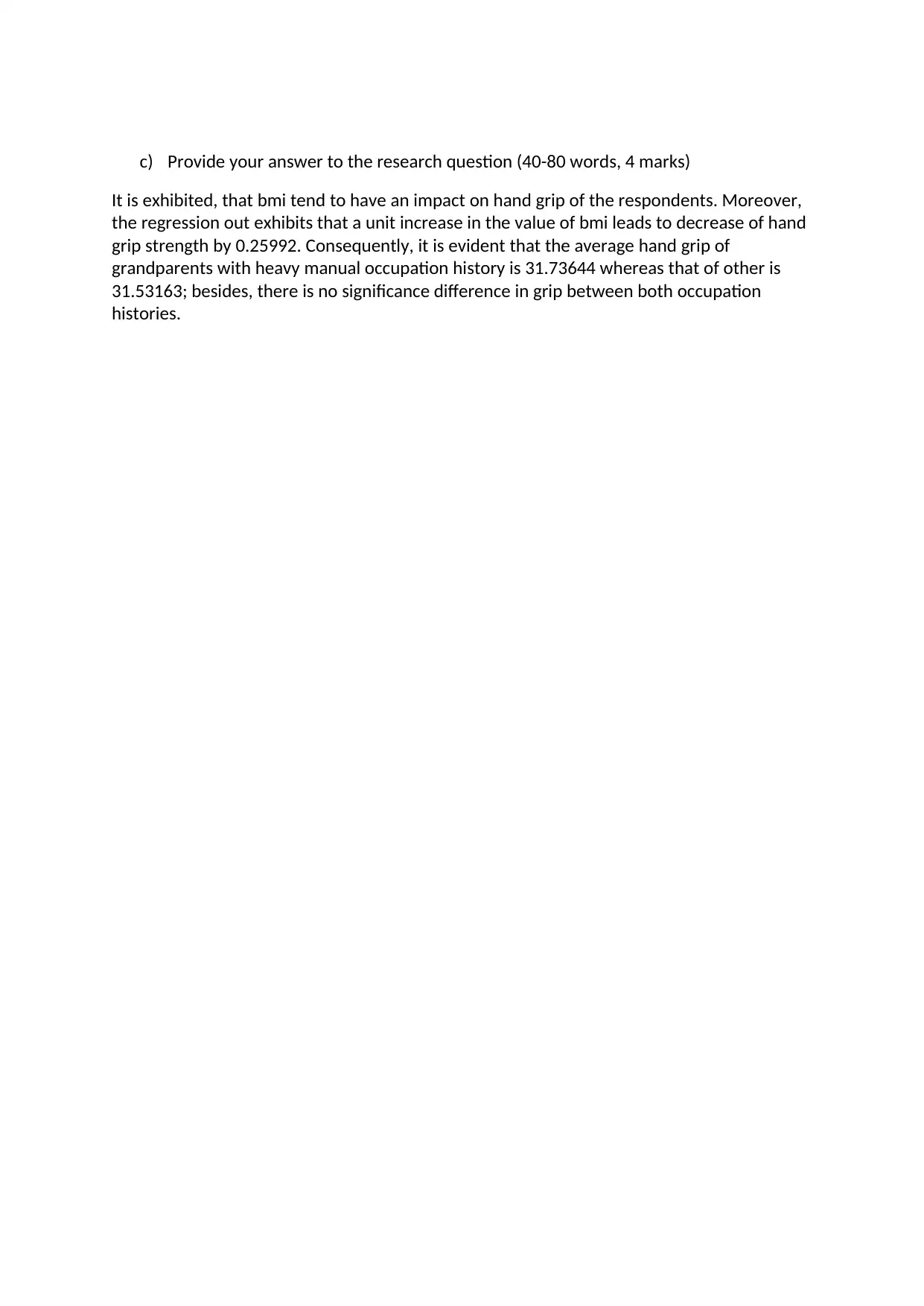
c) Provide your answer to the research question (40-80 words, 4 marks)
It is exhibited, that bmi tend to have an impact on hand grip of the respondents. Moreover,
the regression out exhibits that a unit increase in the value of bmi leads to decrease of hand
grip strength by 0.25992. Consequently, it is evident that the average hand grip of
grandparents with heavy manual occupation history is 31.73644 whereas that of other is
31.53163; besides, there is no significance difference in grip between both occupation
histories.
It is exhibited, that bmi tend to have an impact on hand grip of the respondents. Moreover,
the regression out exhibits that a unit increase in the value of bmi leads to decrease of hand
grip strength by 0.25992. Consequently, it is evident that the average hand grip of
grandparents with heavy manual occupation history is 31.73644 whereas that of other is
31.53163; besides, there is no significance difference in grip between both occupation
histories.
⊘ This is a preview!⊘
Do you want full access?
Subscribe today to unlock all pages.

Trusted by 1+ million students worldwide
1 out of 6
Your All-in-One AI-Powered Toolkit for Academic Success.
+13062052269
info@desklib.com
Available 24*7 on WhatsApp / Email
![[object Object]](/_next/static/media/star-bottom.7253800d.svg)
Unlock your academic potential
Copyright © 2020–2025 A2Z Services. All Rights Reserved. Developed and managed by ZUCOL.


